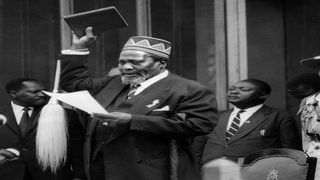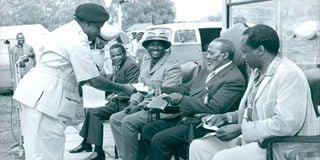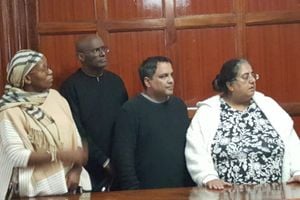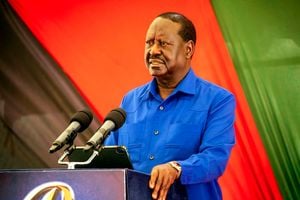
Mzee Jomo Kenyatta takes the oath during his swearing-in as Kenya’s first Prime Minister on June 1, 1963 in Nairobi.
| File | Nation Media GroupNews
Premium
Forget Magufuli, Kenyatta’s long fight with illness was a top State secret too
What you need to know:
- Speculation about Jomo Kenyatta's health started in 1968 and continued until he died in 1978.
When Kenyatta died in August 1978, the nation was caught by surprise because, the nation was never told that he was sickly.
Forget Magufuli, Kenyatta’s long fight with illness was a top state secret too
So you think that Tanzania was secretive about President Magufuli’s illness. Wait. We have been there too – and we are not alone in the long history of hiding presidential illnesses.
It is said that even John F. Kennedy, seemed vibrant and flamboyant but in reality, he was “secretly afflicted by serious medical problems, including Addison’s disease, that his aides concealed from the public.”
When Kenyatta died in August 1978, the nation was caught by surprise because, the nation was never told that he was sickly.
As early as August 1966, Jomo Kenyatta had lashed out at his critics who had claimed that he was sickly, old and planned to retire.
“Here I am – looking fit and healthy,” he told a public rally in Mombasa. But by this time, the British had even started contemplating his death and transition. But he was to last for more than a decade.
But the speculation continued and in 1968, Kenyatta’s personal physician and Defence minister, Dr Njoroge Mungai, told Parliament that Kenyatta “had not suffered a heart attack, coronary thrombosis …or any other illness of that nature.” This was after an MP raised the matter of Kenyatta’s health in parliament.
Dr Mungai only admitted that the president was “slightly indisposed” and blamed “irresponsible demagogues for spreading rumours all over the country that Kenyatta was dead.”
Heart attack
But what we now know is that during this period, Kenyatta had suffered a heart attack and there were questions on who would replace him. That is how Tom Mboya, the Minister for Economic Planning got eliminated from the race with a bullet in 1969.

Chief Kipkemoi arap Sang of Kericho presents a cheque at State Lodge, Nakuru, worth Sh3,000 to President Jomo Kenyatta for construction of Gatundu Hospital and the Forces Memorial Hospital. Looking on (right) is the vice-president Daniel arap Moi and Rift Valley PC Isaiah Mathenge (second left), and the Governor of the Central Bank of Kenya Duncan Ndegwa.
Again in 1972, Kenyatta was reported to have had a massive heart attack while at his Bamburi home and that is when the political realisation that Kenyatta would not last for long emerged. By this time, focus was shifted on the possibility of Daniel arap Moi taking over power. Some politicians, especially from Central Kenya, plotted to kick-start a campaign to change the constitution to bar Moi from automatically taking power for 90 days, pending the election.
Besides possible demise, the international concern in 1974 was about Kenyatta’s capability to continue leading the country.
“Senior Kenyan officials will have to continue coping with aging president who is increasingly withdrawn and irascible, making smooth flow of government business extremely difficult,” a secret US cable noted.
While the Americans were privately reporting, at least in 1975, that Kenyatta’s “only medical problem appears to be recurrence of gout”. It was also known that his heart condition was also causing him problems.
While none of these were ever reported, Kenyans would only watch as the president wore open shoes and used a walking stick.
So vicious was the race to succeed Kenyatta, that it is held in some circles that populist J.M. Kariuki, just like Tom Mboya, was killed in 1975 to ostensibly remove him from the succession.
While the change-the-constitution movement was pegged on Kenyatta’s health, the campaign was stopped in 1976 by Charles Njonjo who warned politicians that it was a criminal offence punishable by death for anyone “to imagine, devise or intend the death or deposition of the president”.
He also added that utterance or declaration of such “imaginations, devices or intentions” was also punishable by a mandatory sentence of life imprisonment.
“Anyone who raises such matters at public meetings or who publishes such matters does so at his peril,” said Njonjo.
Thus, any discussion on Kenyatta’s health was criminalised. But those who met Kenyatta could see that he was quickly going down.
Threats
On Sunday morning, July 4, 1976, the US ambassador to Kenya, Anthony D. Marshall went to see Kenyatta at State House, Nakuru. His mission was to deliver a message from US Secretary of State, Henry Kissinger, on the possible response to threats on Kenya by Uganda’s Idi Amin. With no aides, both retreated to a room.
Kenyatta was worried that after the Entebbe raid, and given Kenya’s role in helping the Israelis, Amin might attack Kenya which had a weak military, by then.
While Marshall told Kenyatta that the US could position ships off the Kenyan coast – “which would be interpreted (by Amin) as support” – he also found that Jomo was sickly, a fact that had not been acknowledged.
While reporting on his meeting to Kenya, Marshall observed in his cable back home: “Kenyatta appeared weak but alert during meeting. His eyes looked somewhat glazed, perhaps from medication. He rose with difficulty to greet me.”
Afraid that his discussion with Kenyatta would, probably, might have been a waste, Marshall decided to get in touch with Minister of State Mbiyu Koinange and Attorney-General Charles Njonjo and make them “aware of substance of secretary’s message and my meeting with Kenyatta.”
In their book, The Kenyatta Succession, journalists Philip Ochieng and Joseph Karimi say by 1976 “the old man had already been worked upon to retire early in 1977, following the party elections planned for March. A prominent politician, Dr Njoroge Mungai, was tipped by the sources to take over as Kenya’s second president.” That explains why Mungai was seeking election as Kanu’s vice-president “or as the super-chairman of all the 41 Kanu-branch chairmen.”
But Mungai’s ambitions had been cut short, nay slowed down, by Njonjo in 1974 when he (Mungai) was defeated by a little-known Dr Johnstone Muthiora in the general election. But Muthiora did not last for long, he died suddenly after falling sick while on a trip in India.
The change-the-constitution movement commenced soon and its rallies were full of threats: “Ta ithui gutiri ngero tutangigera mundu guku thi, tiga gwiciria (There is no harm we cannot do to a person. Don’t think) we are simple. We can organise anything. We are extremely dangerous. Tutiri na itheru. Ithui no tukuinukie (We are not joking. We can have you exit this world) through the back door,” threatened Kihika Kimani.
In May 1978, Charles Njonjo brought a top South African cardiac surgeon, Prof Christiaan Barnard, to have a look at Kenyatta’s heart. It was generally reported that Njonjo’s invitation was as a gratitude for the successful heart operation of two Kenyan girls in South African’s Groote Schuur Hospital – a perfect camouflage of the actual mission. Prof Barnard was a heart transplant pioneer and had been allowed into Kenya, thanks to Njonjo, at a time when the country was not officially allowing its citizens have links with apartheid South Africa.
Kenyatta’s Struggles
It is now known that the entire mission was to examine Kenyatta – and perhaps “strap a pace setter around Mzee.”
But according to Duncan Ndegwa, the former Central Bank of Kenya governor in his autobiography, Walking in Kenyatta’s Struggles, “Mzee would have been the last person to allow his body to be encumbered with mechanical devices to support his heart, no matter how fragile he felt.”
More so, the government decided to set up a heart unit at Kenyatta Hospital.
“Some of those who lived near him lived in fear about his lapses in memory and the possibility of his death. Kenyatta’s memory loss was at times so severe that he could not recall his signature until a copy of the same was shown to him to jog his memory,” writes Ndegwa.
Ndegwa also reported that Kenyatta used to suffer “blackouts from time to time, on occasion for long periods. On one such occasion, he suffered a blackout at his Mombasa Tiririka residence, and remained in coma for three days. They were three days of uncertainty and when he came out I was among the first people to visit him. I asked him what had happened. He replied that he had visited what he called ‘Weru wa Mukaaga.”
In July 1978, as Kenyatta went to open the newly constructed anti-stock theft unit in Nakuru, he was in bad shape. “On stepping out of his limousine to begin the walk towards the place of ceremonies…something happened to the old man, which proved he was in very poor shape,” wrote Karimi and Ochieng in their book. “According to an eyewitness, ‘when Mzee had walked for about 10 feet, I saw him stumble and land on his knees; he stretched his hands out to support himself on the ground. But he was up before his aide could reach him and continued to walk as if nothing had happened, for nobody made any remark about the incident.” After that he made a two paragraph speech and sat down. End of ceremony.
Even as Kenyatta was ailing, it was reported that he was “on busy working holiday” in Mombasa. It was warm there, unlike Gatundu or Nakuru’s Gicheha farm.
Those who saw him on August 3 during his trip to Mombasa attest that he was openly in pain. Eliud Mahihu is quoted in the Kenyatta Succession book saying that “Mzee looked like a ghost…faltered in speech…was incoherent.”
But still, all these were State secrets. Those who saw – were not supposed to say anything. Even when Kenyatta collapsed in public on August 21, the media kept quiet.
[email protected] @johnkamau1





